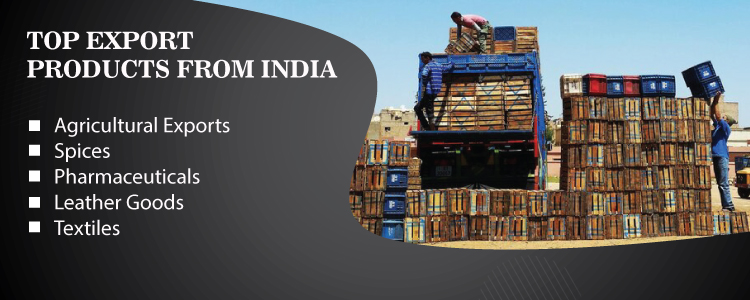Key Indian Exports to the Western Markets: A Statistical Guide
Introduction
As global supply chains evolve, India’s capacity to deliver high-quality, cost-effective products has made it an appealing partner, setting the stage for the nation to become a major export hub for Western markets in the years ahead. In 2023-24, the merchandise exports reached $437.10 billion, showing significant India’s export growth across various sectors. Other important industries such as electronics, pharmaceuticals, engineering goods, iron ore, and textiles contributed greatly to this increase. The leading destinations of trade with western countries for India’s merchandise exports included the USA (17.90%), Netherlands (5.16%), UK (3.00%), Germany (2.27%), and Italy (2.02%).
Let us see the top export products to Western Markets:

1. Agricultural Exports :
India has the largest cattle ranch in the world, the largest area planted with wheat, rice, and cotton, and is the largest producer of milk, pulses, and spices in the world.
India, the second-largest producer of grains, fruits, and vegetables, remains the second-largest exporter of sugar in the world. Among the top three buyers in the years 2024-25 would be the USA, China, and the UAE. India would, at this date, receive imports to the USA valued at 1.26 billion or 10.55% of the total agricultural exports.
As the ultimate objective, the Government of India endeavors to organize virtual buyer-seller meetings (V-BSM) on agricultural and food products with major countries for the furtherance of geographical indication of registered products of agricultural and processed foods in India. There exist 17 VBSMs already organized; its tentacle has reached different nations. The Government has established 13 Agri-Cells in Indian embassies in several countries to provide current and relevant input on Indian exports at these destinations to promote trade, tourism, technology, and investment objectives.
2. Spices
India is known as the ‘Spice Capital of the World’ and rightly so. It accounts for a whopping 75% of spice production across the globe which is made possible with diverse climatic zones and geographical variations. Other factors are a rich history of spice exports that are chemical-free, organic and have Ayurvedic properties since the past 5000 years. This has particularly developed a habit or a routined behaviour of expert cultivation approaches and quality control.
Therefore, the Western countries are hardly able to compete with India in terms of species. The country exports to Vietnam, UK, Saudi Arabia, Germany, and Thailand to name a few. The most commonly exported spices are mustard, dry chillies, coriander, cardamom, turmeric, cumin, black pepper, dried ginger, fennel seeds, nutmeg, and cloves. India is currently increasing its export of spice extracts, oils, and powders instead of just the raw versions. Further, it has plans of expanding into new regions like Africa, Latin America, and similar premium markets. As the demand for natural and organic foods rises, India is likely to add more value with its premium-quality species around the globe.
3. Pharmaceuticals
In 2023-24, the USA, UK, South Africa, Netherlands, and France were the primary export destinations for the Indian pharmaceutical industry. The range of this industry is represented by OTC medicines, Generics, APIs, Vaccines, Biosimilars, and CRM. India’s pharmaceutical sector is projected to soar in its export projection to Rs. 30,76,500 crore ($350 billion) by the year 2047, which will be a 10-15 times increase from the current levels. Having a massive demand for generics obliged India to plan and upgrade its value chain toward specialty generics, biosimilars, and innovative pharmaceuticals.
According to the latest industry data of the United States Food And Drug Administration, the number of market authorizations granted for Indian formulations companies with USFDA approval stood at 6,316, the highest granted to any country, as of April 2023.
4. Leather Goods
Leather is one of the oldest trades in India powered by highly innovative technologies, strong manufacturing base, and vast manpower. Dyed, embossed, textured leather are particularly earning popularity in the Western markets. Wholesale leather accessories are also important products that cater to various taste and fashion preferences around the globe. This is because Indian leather products are widely known for their timeless elegance, style, and durability while adhering to international standards.
The Indian leather export market is ever-growing since it is powered by strong government policies like Sustainable Technology and Environment Protection, Establishment of Institutional Facilities, and Integrated Development of Leather Sector to name a few. Besides government support, leather goods export will continue to grow due to the country’s strong craftsmanship, cost-competitiveness, eco-friendly manufacturing, and premium quality raw materials.
5. Textiles
The government aims to get a domestic textile market worth $1.8 trillion and $100 billion from total exports by 2030 to further boost this to $600 billion by 2047. find giants in international markets, owing to their good artisanship and expertise, from fiber to yarn to fabric to finished product.
Indian cotton, silk, and denim have advanced far enough to be hit beyond borders in different fashion capitals of the world. In 2023-24, the U.S. was the foremost export market for textiles and apparel, taking away 28% of the total T&A exports.
India is identified as the leading exporting nation that is expected to strengthen in 2025 with mobile handsets, pharmacy, engineering goods, agriculture, and textiles sector. Having established low-cost production, qualified labor, and initiatives of the government in bringing investment into the economy, India is positioned to become a crucial player in the global supply chains, mainly for the Western markets. Strengthening its export diversification seems to help India in its international trade and make it an essential hub of the economy.









